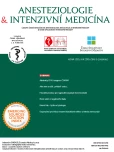Negative pressure pulmonary edema
Authors:
J. Kletečka 1,2; K. Hadrabová 1,2; J.- Beneš 1 3
Authors‘ workplace:
Klinika anesteziologie, resuscitace a intenzivní medicíny, Lékařská fakulta v Plzni, Univerzita Karlova
1; Klinika anesteziologie, resuscitace a intenzivní medicíny, Fakultní nemocnice Plzeň
2; Biomedicínské centrum, Lékařská fakulta v Plzni, Univerzita Karlova
3
Published in:
Anest. intenziv. Med., 30, 2019, č. 5, s. 235-240
Category:
Intensive Medicine
Overview
Negative pressure pulmonary edema (NPPE) is a rare anaesthetic complication, which is not yet mentioned in Czech literature. NPPE is a type of a non-cardiac pulmonary edema, caused by negative intrathoracic pressure following airway obstruction. Young healthy males, able to develop extreme inspiratory effort, are most prone to this complication. NPPE occurs in 0.1 % of all general anaesthetics but is very likely under-diagnosed. Although the treatment is relatively easy and the prognosis is great in most cases, any delay or misdiagnosis can lead to hypoxic damage or death. In this article we describe three cases of possible NPPE recently admitted to our ICU, and discuss the current knowledge of this phenomenon.
Keywords:
pulmonary edema – airway obstruction – complications of the anaesthesia
Sources
1. Tami TA, Chu F, Wildes TO, Kaplan M. Pulmonary edema and acute upper airway obstruction. Laryngoscope. 1986;96 : 506–509.
2. Oswalt CE, Gates GA, Holmstrom MG. Pulmonary edema as a complication of acute airway obstruction. JAMA. 1977;238 : 1833–1835.
3. Capitanio MA, Kirkpatrick JA. Obstructions of the upper airway in children as reflected on the chest radiograph. Radiology. 1973;107 : 159–161.
4. Jackson FN, Rowland V, Corssen G. Laryngospasm-induced pulmonary edema. Chest. 1980;78 : 819–821.
5. Westreich R, Sampson I, Shaari CM, Lawson W. Negative--pressure pulmonary edema after routine septorhinoplasty: discussion of pathophysiology, treatment, and prevention. Arch Facial Plast Surg. 2006;8 : 8–15.
6. Alonso JV, Tucker S, Lakshmanan G, Stokes A. Dover sole. Am J Emerg Med. 2018;36 : 1321.e5–1321.e6. Epub 2018 Mar 21.
7. Galvis AG. Pulmonary edema complicating relief of upper airway obstruction. Am J Emerg Med. 1987;5 : 294–297.
8. Bhaskar B, Fraser JF. Negative pressure pulmonary edema revisited: Patophysiology and review of management. Saudi J Anaesth. 2011;5 : 308–313.
9. Lemyze M, Mallat J. Understanding negative pressure pulmonary edema. Intensive Care Med. 2014;40 : 1140–1143.
10. Cook CD, Mead J. Maximum and minimum airway pressures at various lung volumes in normal children and adults. Fed Proc. 1960;19 : 377.
11. Buda AJ, Pinsky MR, Ingels NB Jr, et al. Effect of Intrathoracic Pressure on Left Ventricular Performance N Engl J Med. 1979;301 : 453–459.
12. West JB, Mathieu-Costello O. Stress failure of pulmonary capillaries: role in lung and heart disease. Lancet 340 : 762–767.
13. Papaioannou V, Terzi I, Dragoumanis C, Pneumatikos I. Negative-pressure acute tracheobronchial hemorrhage and pulmonary edema. J Anesth. 2009;23 : 417–420.
14. Austin A, Modi A, Judson MA, et al. Sevoflurane induced diffuse alveolar hemorrhage in a young patient. Respir Med Case Rep. 2017;20 : 14–15.
15. Givertz, MM. Noncardiogenic pulmonary edema. UpToDate [online] 2015 [cit. 26.11.2015]; dostupné z: https://www.uptodate.com/contents/noncardiogenic-pulmonary-edema
Labels
Anaesthesiology, Resuscitation and Inten Intensive Care MedicineArticle was published in
Anaesthesiology and Intensive Care Medicine

2019 Issue 5
Most read in this issue
- Fascial planes for regional anaesthesia of the upper limb
- Negative pressure pulmonary edema
- Abstrakty XXVI. kongresu ČSARIM Brno 2019
- How did we learn to „control“ the heart...
